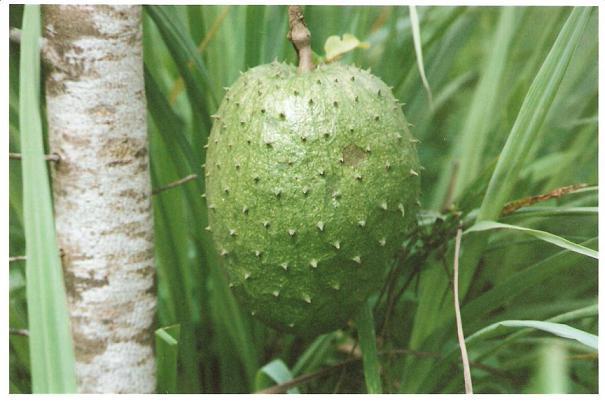Guanabana fruit on a three year old tree.
Guanabana is a relatively small, fast growing, evergreen tree, originally from tropical America. Today it is cultivated in tropical countries all around the world. The tree has a dense crown full of dark green, laurel-like leaves which have spicy sort of aroma when crushed. The tree has a high tolerance of alkaline soils and drought and is easily propagated from seed. A seedling will begin to produce fruit steadily within three years after planting.
The blooms are typical of the Annonaceae family with three fleshy, triangular petals that abort once the flower is pollinated. Flowers have an unpleasant odor that attracts flies and other insects. The fruits vary in shape and size, but are generally always longer than they are wide, and are covered with protuberances, soft, green prickles about ¼ an inch long and curved, they can grown up to eight pounds, probably more, and have a very fragrant and delicate, thin, white, fleshy, edible pulp embedded with hard black oval seeds.
The Guanabana is eaten raw, in juices, ice creams and blended drinks. It is also used to flavor sweets and jellies. Various medicinal properties are attributed to the fruit, the leaf and the bark. The fruit pulp is rich in vitamins B and C, and in phosphorous, and contains up to 12% sugar. This is a species adapted to hot areas and cannot be grown successfully above 1,000 meters. The tree requires protection from winds and prefers acidic soils, deep and rich in organic matter, although it can adapt to all kinds of soils as long as they provide good drainage.
In South East Asia the leaves are known for their sleep inducing properties, a tea is brewed with them or they are simply placed under the pillow. The fruit pulp is used to treat fever, diarrhoea and scurvy. Green fruit and seeds of most Annona species are known for their insecticidal properties.
Annona muricata cross section.


